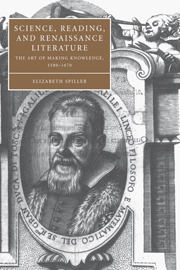Book contents
- Frontmatter
- Contents
- List of figures
- Acknowledgments
- Introduction: making early modern science and literature
- 1 Model worlds: Philip Sidney, William Gilbert, and the experiment of worldmaking
- 2 From embryology to parthenogenesis: the birth of the writer in Edmund Spenser and William Harvey
- 3 Reading through Galileo's telescope: Johannes Kepler's dream for reading knowledge
- 4 Books written of the wonders of these glasses: Thomas Hobbes, Robert Hooke, and Margaret Cavendish's theory of reading
- Afterword: fiction and the Sokal hoax
- Notes
- Index
- Cambridge Studies in Renaissance Literature and Culture
Introduction: making early modern science and literature
Published online by Cambridge University Press: 22 September 2009
- Frontmatter
- Contents
- List of figures
- Acknowledgments
- Introduction: making early modern science and literature
- 1 Model worlds: Philip Sidney, William Gilbert, and the experiment of worldmaking
- 2 From embryology to parthenogenesis: the birth of the writer in Edmund Spenser and William Harvey
- 3 Reading through Galileo's telescope: Johannes Kepler's dream for reading knowledge
- 4 Books written of the wonders of these glasses: Thomas Hobbes, Robert Hooke, and Margaret Cavendish's theory of reading
- Afterword: fiction and the Sokal hoax
- Notes
- Index
- Cambridge Studies in Renaissance Literature and Culture
Summary
What is fact and what is fiction? This question may be philosophically vexed. Yet, we all feel confident in a day to day kind of way that we know what fact and fiction are, if not always which is which. While the categories of fact and fiction structure how we apprehend the world on a very basic level, much of what we think we know about fact and fiction may be little more than a fiction. First, these categories are historically and culturally specific, ones that are invented as we understand them sometime during the seventeenth century. Second, we have become used to thinking that what separates a lie from the truth, literature from science, is a question of content. The right dates and data can transform romance into history or alter a valid report into a scientific fraud. Literature is fiction and science is fact. Yet, as we shall see throughout this study, early modern writers recognize how knowledge involves form as well as content. The early modern period is an age of discovery: these discoveries include not simply new knowledge but new definitions of knowledge. For early modern writers, the existence of science depends on the possibility of fiction; literature acquires meaning and validity against the framework of fact. Early modern imaginative literature and experimental science are inventions of a startling new attention to knowledge: they represent new ways of thinking, new understandings of how man could create knowledge, and new ways of writing that try to recreate those ideas for readers.
- Type
- Chapter
- Information
- Science, Reading, and Renaissance LiteratureThe Art of Making Knowledge, 1580–1670, pp. 1 - 23Publisher: Cambridge University PressPrint publication year: 2004



